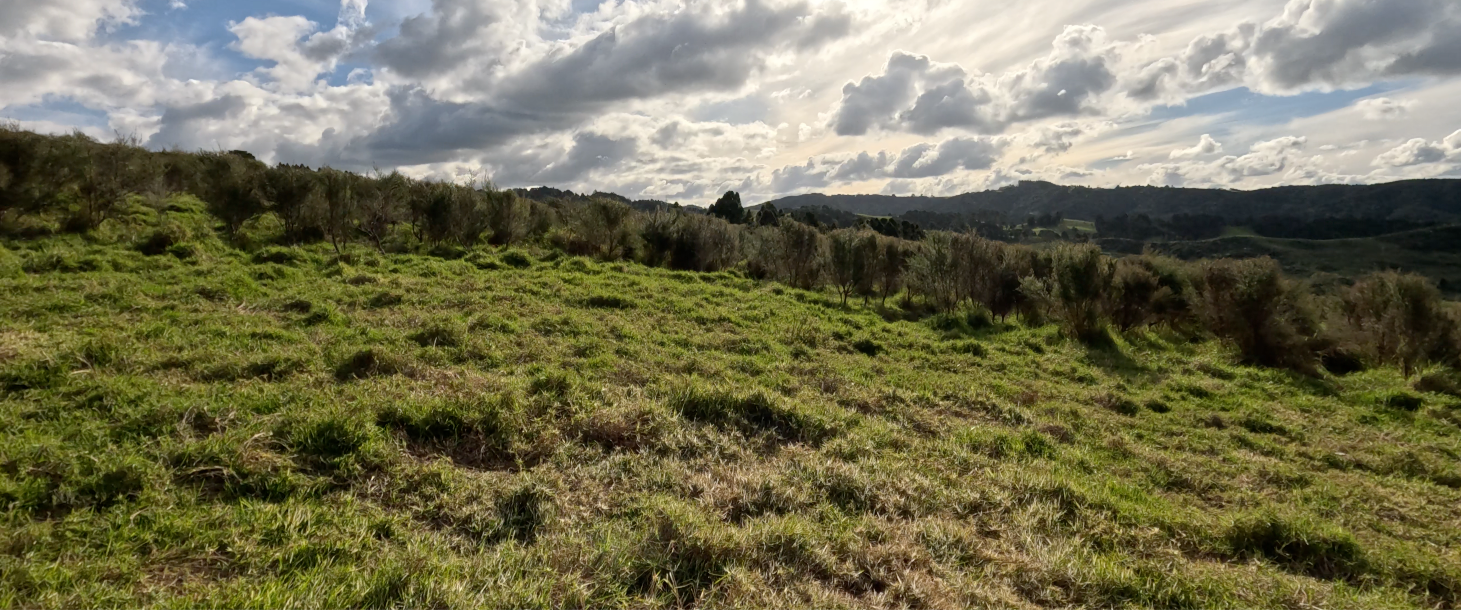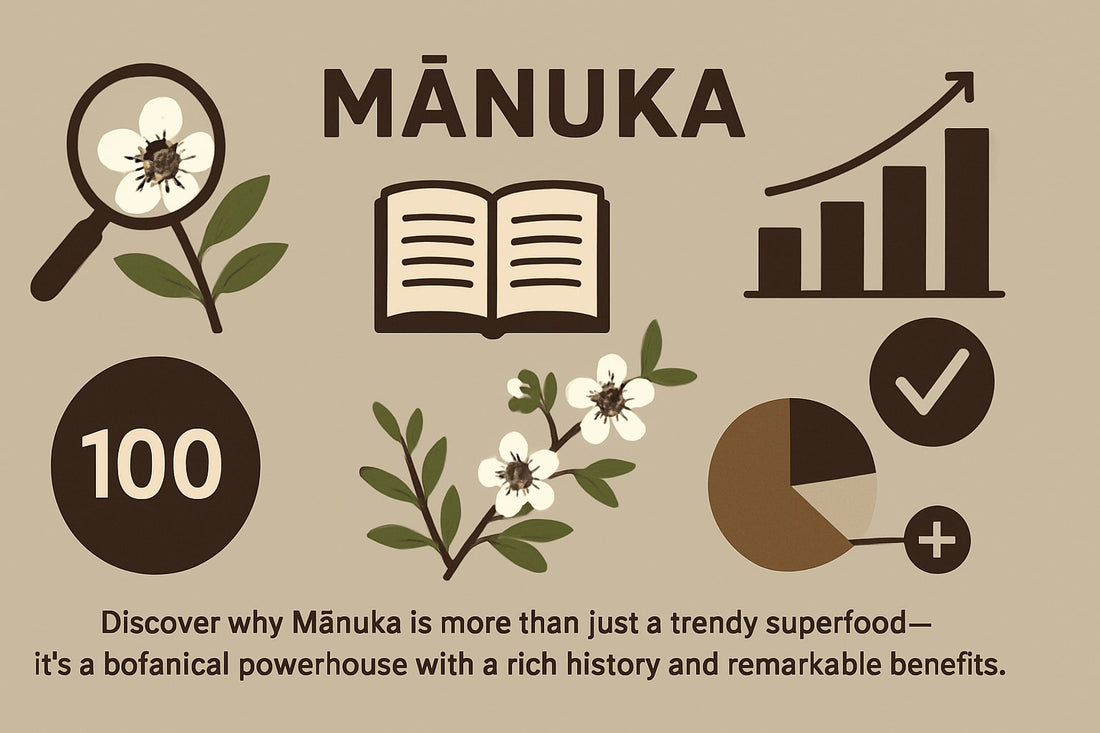
The Essential Guide to Mānuka: Benefits, Uses, and Origins 2025
Curious about why mānuka is capturing attention across the globe? This remarkable plant is far more than just a wellness trend. With a legacy rooted in Māori tradition and a profile packed with unique natural compounds, mānuka is now at the forefront of scientific research and holistic health.
In this essential guide, you’ll discover how mānuka’s story stretches from native forests to modern skincare and nutrition. We’ll explore its cultural origins, potent bioactive properties, and the diverse ways it’s being used today.
Ready to unlock the secrets behind its rising popularity? Learn how mānuka can benefit your daily routine and empower you to make smarter choices as we look ahead to 2025.
The Origins of Mānuka: From Native Shrub to Global Icon
Mānuka is more than a buzzword in natural wellness. It stands tall as a botanical icon, with roots in the rugged landscapes of New Zealand and south-east Australia. Its story spans from ancient forests to modern science, captivating both nature lovers and researchers alike.
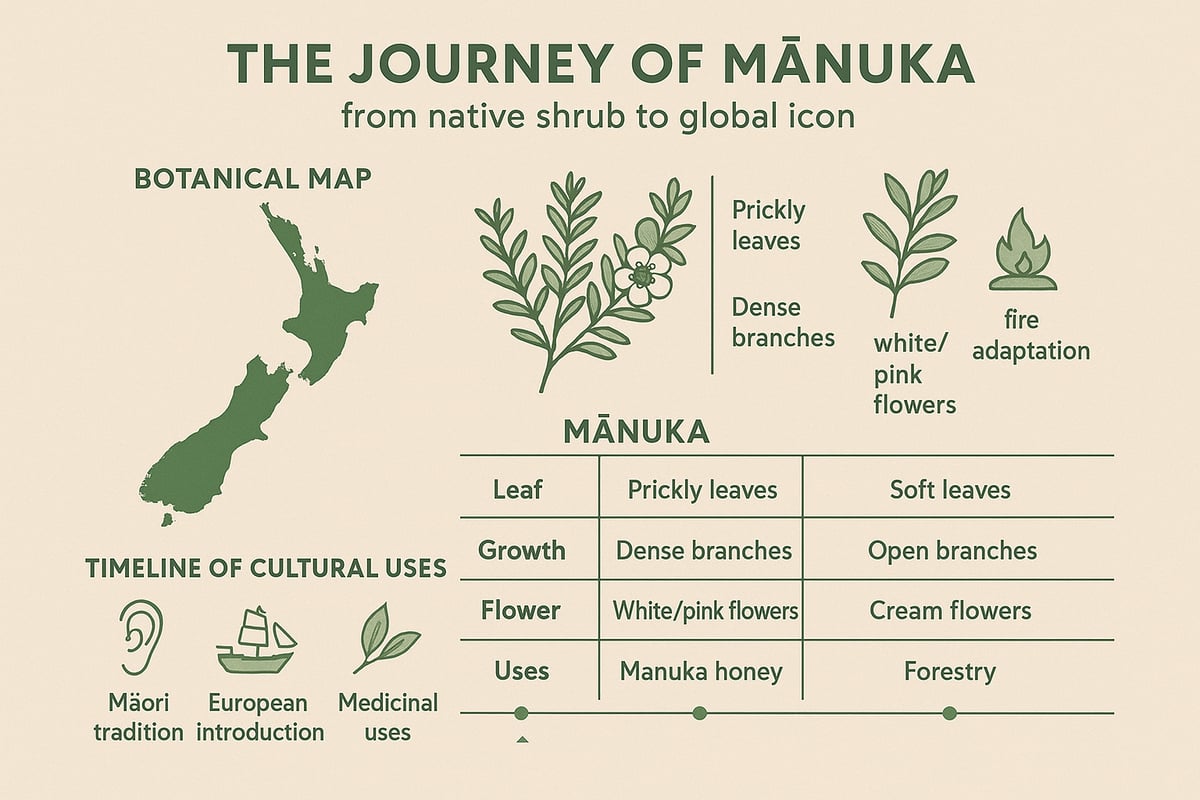
Botanical Profile and Natural Habitat
Scientifically known as Leptospermum scoparium, mānuka belongs to the Myrtaceae family. This evergreen shrub or small tree typically grows between 2 and 5 metres tall. Its dense, prickly branches and small, sharp leaves make it instantly recognisable in the wild.
Mānuka thrives across New Zealand, including the Chatham Islands, and extends into Tasmania, Victoria, and New South Wales. It’s a pioneer species, often the first to regenerate disturbed land, providing crucial shelter and habitat for native wildlife.
Fire plays a unique role in mānuka’s lifecycle, especially in Australian populations. The shrub can regenerate after bushfires thanks to traits like serotiny (seed release in response to heat) and lignotubers (woody swellings at the base). This resilience helps mānuka support biodiversity and maintain healthy ecosystems.
Distinguishing mānuka from its close relative, kānuka, is vital for botanists and enthusiasts. Mānuka has pricklier leaves and larger seed capsules, while kānuka is softer and less spiky.
| Feature | Mānuka | Kānuka |
|---|---|---|
| Leaf texture | Prickly, sharp | Soft, less prickly |
| Seed capsule size | Larger | Smaller |
| Flower colour | White or pink | White |
Chemically, mānuka populations differ across regions. New Zealand mānuka is renowned for its high triketone content, while Australian plants may show more diversity in pinenes and sesquiterpenes. Geographic isolation over time has driven subtle evolutionary changes, shaping the plant’s unique chemistry and resilience.
Cultural and Historical Significance
The name “mānuka” has deep Māori origins, tracing back to Proto-Polynesian language roots. For centuries, mānuka was woven into Māori daily life and traditional medicine. Its tough wood built tools, weapons, and shelters, while its leaves and bark offered remedies for fevers, stomach issues, and burns.
Māori healers valued mānuka’s versatility. They used infusions to ease ailments, and even the gum to soothe burns or coughs. The bark was prized for its waterproofing qualities, making it invaluable for containers and roofing.
When Europeans arrived, they adopted mānuka as the “tea tree,” famously brewing its leaves as a vitamin-rich tea. The plant’s reputation soon spread, becoming a symbol of resilience and natural healing in New Zealand’s identity.
Today, mānuka features in conservation projects and continues to inspire research worldwide. Its story is celebrated in both indigenous and scientific circles, bridging ancient wisdom with modern discovery. For those keen to dive deeper, the Library of mānuka knowledge is a valuable resource to explore its remarkable legacy.
The Unique Bioactive Compounds of Mānuka
Mānuka is celebrated worldwide for its remarkable natural chemistry, setting it apart from other botanicals. These unique compounds are the secret behind mānuka’s growing reputation in wellness, skin care, and beyond.

Triketones, Grandiflorone, and Other Key Actives
At the heart of mānuka’s power are its triketones. These are rare bioactive molecules, with New Zealand mānuka varieties boasting a minimum triketone content of 35%. This high concentration is especially notable in Waipu mānuka, which stands out from other regions.
Grandiflorone is another key triketone. Normally, its levels are very low when mānuka is processed with traditional hydrodistillation. However, Waipu Extracts’ advanced supercritical extraction maintains grandiflorone between 15 and 25%. This keeps a broader spectrum of mānuka’s natural benefits intact.
Other important actives in mānuka include pinene, sesquiterpenes, and eucalyptol. Each chemotype, or chemical profile, varies by region and even by extraction method. For example, Australian mānuka typically shows different balances of these compounds compared to New Zealand mānuka.
| Compound | NZ Mānuka (Waipu) | Australian/East Cape Mānuka |
|---|---|---|
| Triketones | 35%+ | 2–20% |
| Grandiflorone | 15–25% (Waipu) | Lower, varies |
| Pinenes | Moderate | High/moderate |
| Sesquiterpenes | Moderate | Moderate to High |
Full-spectrum extraction is crucial for keeping this chemical diversity. To learn more about the importance of triketones, see What are triketones in mānuka.
Science, Efficacy, and Standards
Why do these mānuka compounds matter? Scientific studies show that triketones have potent antimicrobial and antifungal effects. This means mānuka, oil, and extracts can help fight bacteria, soothe skin, and even support wound healing.
The efficacy of mānuka products depends on the concentration and diversity of these actives. Products with high triketone levels, like those from Waipu (NZ), are especially valued for their purity and strength.
To ensure you get genuine mānuka benefits, look for products with clear regulatory standards. In honey, the Unique Mānuka Factor (UMF) and Methylglyoxal (MGO) ratings help verify quality and potency. For oils and extracts, check for triketone content and full-spectrum claims.
In summary, mānuka’s bioactive profile is what makes it a true natural powerhouse. Next time you pick up a mānuka product, remember that its unique chemistry is the key to its wellness benefits.
Health and Wellness Benefits of Mānuka
Unlocking the full health potential of mānuka has become a global wellness pursuit. This remarkable plant delivers a spectrum of science-backed benefits, making it a staple in modern natural medicine cabinets.
Evidence-Based Therapeutic Properties
What makes mānuka such a standout in natural health? Its unique blend of bioactive compounds, especially methylglyoxal (MGO) in honey and triketones in extracts, sets it apart. These actives have been extensively studied for their antibacterial power, with mānuka honey showing effectiveness even against resistant bacteria.
Clinical research supports mānuka’s wound healing prowess. Medical-grade mānuka honey is used in hospitals for burns, ulcers, and skin repair. It helps reduce infection, speeds up tissue regeneration, and minimises scarring.
Mānuka’s anti-inflammatory properties soothe redness, swelling, and irritation. This makes it helpful for sensitive, inflamed skin and chronic conditions. Studies also show mānuka’s antifungal and antiviral actions, offering relief for skin and respiratory issues.
Immune system support is another traditional and modern use. Mānuka compounds are believed to modulate immune responses, helping your body respond to stress and infection.
Gut health is a growing area of research. Mānuka honey is used for digestive discomfort and stomach ulcers, supporting healthy gut flora. In oral care, mānuka-based mouthwashes and toothpastes lower plaque and gum disease rates, supporting overall dental health.
Safety is top of mind for many. Mānuka products are generally well tolerated, even for children and the elderly, making them a gentle option for the whole family.
Here’s a quick summary of key benefits:
| Benefit | Evidence Base | Common Use Cases |
|---|---|---|
| Antibacterial | Clinical studies | Wounds, infections |
| Wound healing | Hospital use | Burns, ulcers, skin repair |
| Anti-inflammatory | Lab & clinical | Eczema, dermatitis |
| Antifungal | Research | Athlete’s foot, dandruff |
| Immune support | Traditional/modern | Wellness, prevention |
| Gut/oral health | Clinical/lab | Ulcers, dental care |
For real-life success stories, see how Clearing eczema with mānuka has provided rapid relief where conventional remedies fell short.
Waipu Extracts: Advancing Mānuka Skin Solutions
Waipu Extracts have set a new benchmark in mānuka skincare. Their world-first, full-spectrum mānuka extract retains a minimum triketone content of 35%. Thanks to supercritical extraction, grandiflorone levels are kept high between 15–25%, far above what’s possible with traditional hydrodistillation.
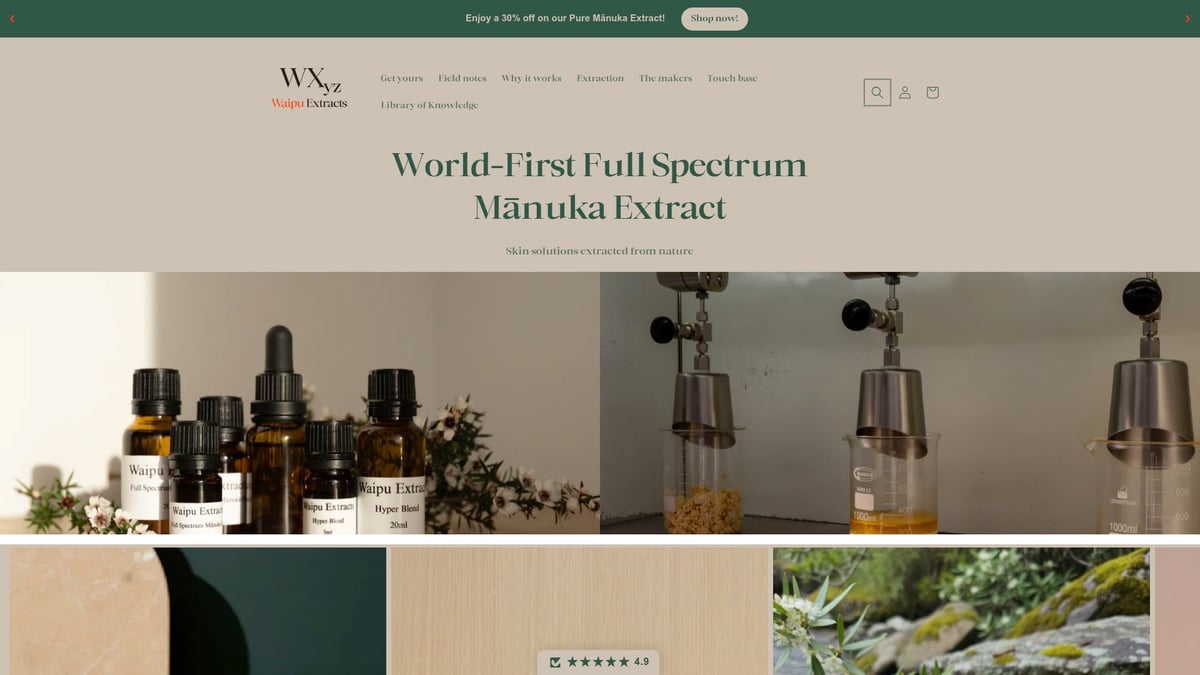
This potent profile delivers proven results for challenging skin conditions like eczema, dandruff, acne, psoriasis, and dermatitis. Customers regularly report quick relief, even when other treatments have failed.
Waipu’s mānuka solutions are natural, steroid-free, and suitable for all ages. With a commitment to purity and efficacy, and a strong local New Zealand focus, they offer free express shipping to make advanced mānuka care accessible.
Choosing mānuka products like Waipu Extracts means prioritising quality, safety, and visible results for your skin and wellbeing.
Traditional and Modern Uses of Mānuka
For centuries, mānuka has played a central role in the daily life, wellbeing, and traditions of Aotearoa New Zealand. From ancient Māori medicine to today’s global wellness trends, the versatility of this native shrub is truly remarkable.
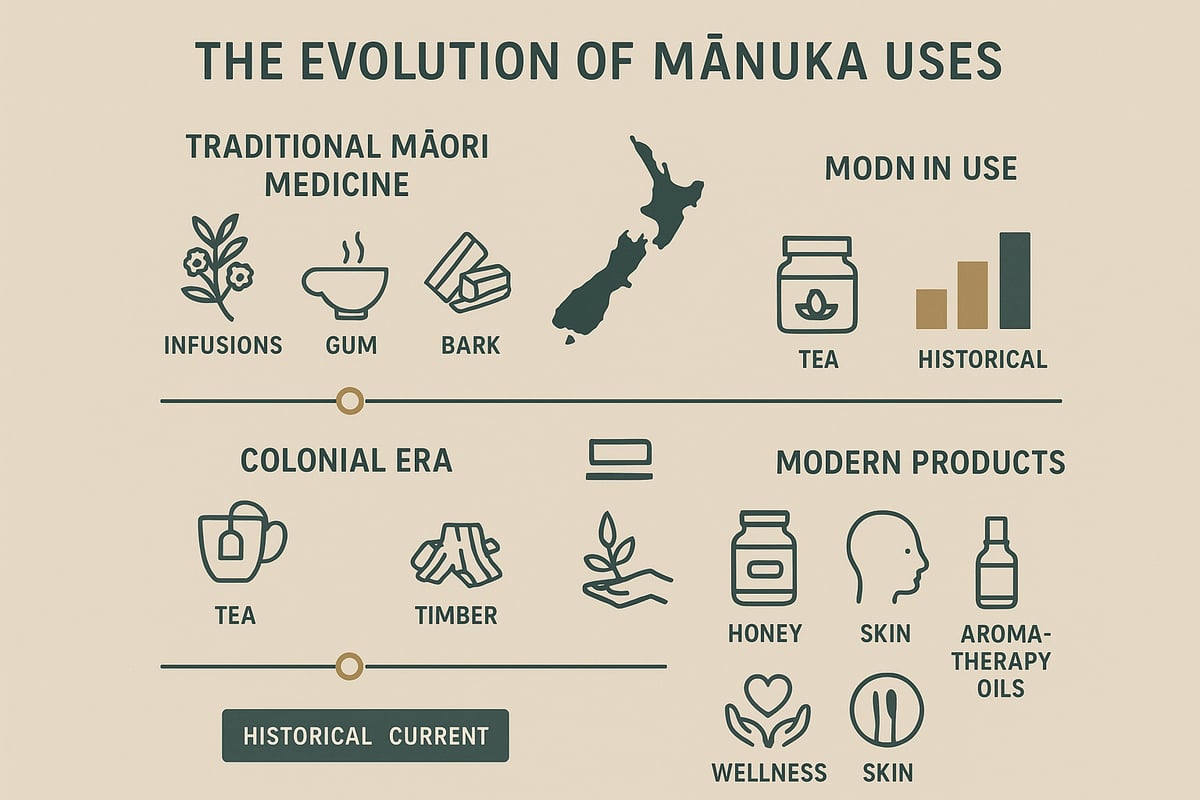
Māori Traditions and Everyday Life
Māori communities have long treasured mānuka for its healing and practical benefits. Infusions made from mānuka leaves helped relieve fevers, stomach discomfort, and urinary issues. The gum was applied to burns and wounds, or chewed to ease coughs and soothe sore throats.
Bark decoctions provided a natural sedative and oral care, while the sturdy wood was fashioned into spears, paddles, and building materials. The bark’s waterproof qualities made it perfect for containers and traditional roofing.
Spiritual and Colonial Significance
Beyond its physical uses, mānuka held spiritual meaning. Seen as a divine gift, it featured in protective rituals and ceremonial healing. Such reverence reflected a deep respect for the land and its resources.
Early European settlers quickly adopted mānuka, brewing the leaves as a tea to ward off scurvy, which is how the “tea tree” nickname emerged. Mānuka timber became a staple for fences, tool handles, and even shipbuilding thanks to its durability.
Modern Wellness and Skincare
Aromatherapy uses mānuka essential oil for stress relief and air purification. In the kitchen, mānuka honey and teas are enjoyed for their unique flavour and health benefits. The surge in demand for mānuka honey reflects its global popularity, with the Manuka Honey Market Growth Analysis showing rapid expansion as more people turn to natural wellness solutions.
Broader Applications: Food, Animal Care, and Sustainability
Mānuka’s reach extends beyond humans. In agriculture, it helps with animal wound care and serves as a natural pest control agent. Culinary uses continue to evolve, with honey, teas, and infusions appearing in creative recipes and gourmet products.
Whether as a traditional remedy or a modern super-ingredient, mānuka remains a symbol of resilience, adaptability, and holistic wellness. Its journey from indigenous knowledge to international acclaim reflects the enduring power of nature to support our health and daily lives.
How to Choose and Use Mānuka Products in 2025
Selecting the right mānuka product can feel overwhelming, especially with so many options on the market. Not all mānuka is created equal, so understanding what to look for ensures you get the best quality and results.
Understanding Quality and Authenticity
When shopping for mānuka, start by checking the label. Look for certifications like UMF (Unique Mānuka Factor) and MGO (Methylglyoxal) that indicate potency and authenticity. UMF rates overall antibacterial strength, while MGO measures a key active compound.
For mānuka oil and extracts, pay attention to triketone content. High triketone levels, like the minimum 35% found in Waipu mānuka, signal strong antimicrobial potential. Full-spectrum claims mean a broad range of bioactives is preserved, delivering more holistic benefits.
Counterfeit mānuka is a real concern, given soaring global demand. Choose trusted brands and always verify batch numbers or QR codes when available. Extraction methods matter too. Supercritical extraction, for example, can retain higher concentrations of rare actives like grandiflorone. To learn more about this advanced process, see Supercritical fluid extraction explained.
Here’s a quick comparison table to guide your label reading:
| Label Term | What It Means | Why It Matters |
|---|---|---|
| UMF | Unique Mānuka Factor | Overall potency |
| MGO | Methylglyoxal content | Antibacterial strength |
| Triketones | Active compounds in oil/extract | Antimicrobial efficacy |
| Full-spectrum | Broad range of actives | Holistic benefits |
Choosing, Using, and Storing Mānuka Products
Mānuka comes in many forms. Honey is popular for gut health, immune support, and wound care. Oil and extracts are ideal for skin, scalp, and oral care. Balms soothe eczema, cuts, and rashes. Always match the mānuka product type to your need.
Dosage matters: take 1–2 teaspoons of mānuka honey daily for wellness, or apply a thin layer to wounds. For topical oils or balms, patch test first, then use as directed. Integrate mānuka into your daily routine—add honey to tea, use oil for blemishes, or keep a balm in your first aid kit.
To preserve potency, store mānuka honey in a cool, dark place. Oils and balms should be sealed, away from direct sunlight. Check expiry dates and follow storage advice on packaging.
Choose mānuka from ethical producers who prioritise sustainability and native habitat protection. As research and extraction methods evolve, expect even more powerful and diverse mānuka products in 2025.
The Future of Mānuka: Trends, Research, and Conservation
The future of mānuka is bright, with science, tradition, and conservation converging to shape what lies ahead. As we look to 2025 and beyond, new discoveries and global demand are transforming mānuka into a symbol of both innovation and environmental responsibility.
Ongoing Research and Extraction Advances
Researchers are delving deeper into mānuka’s potential for skin, gut, and immune health. Clinical trials are underway, exploring how mānuka compounds can support wound healing, balance the microbiome, and boost immunity.
Extraction technologies are also evolving. Supercritical CO2 methods now allow producers to retain a broader spectrum of bioactives, including high triketone content. These advances mean mānuka extracts are more potent, consistent, and suitable for a wider range of applications, from advanced skincare to targeted supplements.
Conservation and Indigenous Partnerships
The sustainability of mānuka relies on protecting native habitats and supporting biodiversity. Conservation efforts focus on restoring wild populations, promoting regenerative farming, and minimising environmental impact.
Ongoing challenges include climate change and the risk of overharvesting. By regenerative planting practices producer can protect mānuka for future generations.
Market Growth, Regulation, and Consumer Education
Global interest in mānuka is surging, with the market projected to expand rapidly through the next decade. According to the Manuka Honey Market Size and Forecast, demand for mānuka products is driving innovation, exports, and new product development.
Regulatory standards are evolving to protect authenticity and quality. Certifications like UMF and MGO ratings help consumers identify genuine mānuka, while anti-counterfeit measures are becoming more robust.
Consumer education is vital. Understanding labels, sourcing ethically, and recognising real mānuka will empower buyers to make informed choices. As research and technology progress, mānuka is set to remain a botanical icon in wellness and sustainability.
If you’re feeling inspired by everything we’ve uncovered about Mānuka’s origins, unique compounds, and powerful benefits, you’re not alone—I’ve seen firsthand the difference these natural solutions can make. Whether you’re managing eczema, breakouts, or just want to support your skin with the best nature has to offer, it’s reassuring to know you can trust a science-backed approach that honours both tradition and innovation. Ready to experience the healing potential of full spectrum Mānuka for yourself Take the next step and Get Your Mānuka Extract Today.

